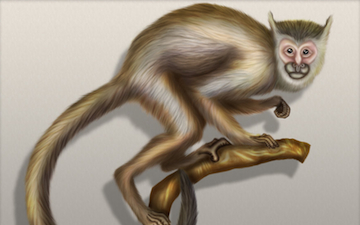Geoffroy’s Spider Monkey, Ateles geoffroyi, also known as Black-handed Spider Monkey,[3] is a species of spider monkey, a type of New World monkey, from Central America, parts of Mexico and possibly a small portion of Colombia. There are at least five subspecies. Some primatologists classify the Black-headed Spider Monkey, A. fusciceps, found in Panama, Colombia and Ecuador as the same species as Geoffroy’s Spider Monkey.
It is one of the largest New World monkeys, often weighing as much as 9 kilograms. Its arms are significantly longer than its legs, and it has aprehensile tail that can support the entire weight of the monkey and that is used as an extra limb. Its hands have only a vestigial thumb, but long, strong hook-like fingers. These adaptations allow the monkey to move by swinging by its arms beneath the tree branches.
Geoffroy’s Spider Monkey lives in fission–fusion societies that contain between 20 and 42 members. Its diet consists primarily of ripe fruit and it requires large tracts of forest to survive. As a result of habitat loss, hunting and capture for the pet trade, it is considered to be endangered by the International Union for Conservation of Nature (IUCN).
Geoffroy’s Spider Monkey is one of the largest New World monkeys. Its length measures between 30 and 63 cm (12 and 25 in) and it weighs between 6 and 9 kg (13 and 20 lb).[3][9] The tail is longer than the body at between 63 and 85 cm (25 and 33 in).[3][9] Males are slightly larger than females.[10]
Its body color varies by subspecies and population and can be buff, reddish, rust, brown or black.[3][11][12] The hands and feet are dark or black.[13] The face usually has a pale mask around the eyes and muzzle.[9]
Its arms and legs are long and slim.[14] The arms are about 25% longer than the legs.[15] There is only a vestigial thumb, but the fingers are long and strong, making the hands hook-like.[15][16] The long arms and hook-like hands allow Geoffroy’s Spider Monkey to brachiate, that is, swing by its arms beneath the tree branches.[15]
The prehensile tail is very strong and has a palm-like pad at the end. The tail acts as an extra limb, and is used for locomotion as well as to pick fruits and to scoop water from holes in trees.[15] Geoffroy’s Spider Monkey can support its weight suspended by its tail and often does so when feeding.[12]
Geoffroy’s Spider Monkey is one of the largest New World monkeys. Its length measures between 30 and 63 cm (12 and 25 in) and it weighs between 6 and 9 kg (13 and 20 lb).[3][9] The tail is longer than the body at between 63 and 85 cm (25 and 33 in).[3][9] Males are slightly larger than females.[10]
Its body color varies by subspecies and population and can be buff, reddish, rust, brown or black.[3][11][12] The hands and feet are dark or black.[13] The face usually has a pale mask around the eyes and muzzle.[9]
Its arms and legs are long and slim.[14] The arms are about 25% longer than the legs.[15] There is only a vestigial thumb, but the fingers are long and strong, making the hands hook-like.[15][16] The long arms and hook-like hands allow Geoffroy’s Spider Monkey to brachiate, that is, swing by its arms beneath the tree branches.[15]
The prehensile tail is very strong and has a palm-like pad at the end. The tail acts as an extra limb, and is used for locomotion as well as to pick fruits and to scoop water from holes in trees.[15] Geoffroy’s Spider Monkey can support its weight suspended by its tail and often does so when feeding.[12]
(From Wikipedia, January 3rd, 2011)
—
Black-handed spider monkeys are sociable animals and tend to live in multi-male, multi-female groups of 4 to 35 individuals (average around 15), although groups of up to 100 have been reported (2) (7) (8). These are fission-fusion communities, meaning that they usually split up into smaller subgroups to forage, particularly when food resources are scarce (6). This diurnal species relies heavily on a diet of fruit, but will also eat leaves, flowers, and occasionally bark, nuts, seeds, insects, arachnids and eggs (4) (8). Females actively choose their mates and initiate copulation, and breeding may take place at any time of the year (4). Females give birth to a single infant every two to four years, after a gestation period of seven to eight months (4) (9). Young are normally dependent on their mothers for three years, and reach sexual maturity at four years for females, five for males, after which females usually migrate to other groups (7).
These monkeys eat mainly ripe friut and less frequently leaves and flowers. They may also eat some nuts, seeds, insects, arachnids, and eggs.
These animals are social and tend to form groups of approximately thirty individuals. Groups of up to 100 have been reported. For the most part, these large groups split into smaller subgroups to forage and only for a few weeks out of the year is the whole group together. Group size varies with habitat type and seems to depend largely on the productivity of the area.
These spider monkeys live mainly in the top of the tree canopy where they forage diurnally. They tend to feed heavily in the early morning and to rest for the remainder of the day. These monkeys are among the most agile of the primates and are often seen hanging by one limb or by the tail, which essentially functions as a fifth limb. They walk nimbly along the upper surfaces of branches and are able to pick things up with their tails.
– – –




